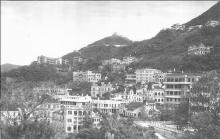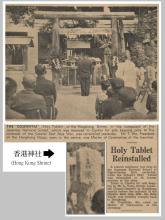The AMO have proposed this building should be a Grade 1 listed building. Here is their assessment:
Historical Interest
Land records show that the lease on the property (Inland Lot No. 1378) commenced on 11 May 1896 when Harry Bathurst purchased the lot together with the dwelling house thereon known as No. 26 Kennedy Road “Medway House”. In 1900, the ownership of the lot was transferred to Mr. Li Po-lung (李 寶龍) and Mr. Li Po-yung, the former being a businessman who developed the slope near Belcher Street (卑路乍街) and Sands Street (山市街) in Kennedy Town into a residential area for the wealthy Chinese in the early 20th century. Still later, in 1919, the ownership of the land lot was transferred to the Japanese.
The existing building was constructed by donations from Japanese companies in Hong Kong. In around 1935, the Japanese Primary School Hong Kong, which was located at No. 12 Kennedy Road, was moved to No. 26 Kennedy Road where a new building containing one auditorium, four teachers’ quarters, and six classrooms for 300 students was constructed. After the war, the building was respectively occupied by the Queen’s College between 1947 and 1950, the Government Vernacular Senior Middle School (now known as the Clementi Secondary School) between 1946 and 1961, the Kennedy Road Junior School between 1961 and 1991 and the Hong Kong International School between 1991 and 1999. Since 1999, it has been run as the St. Paul’s Co-Educational (Kennedy Road) Primary School, one of the two affiliated primary schools of St. Paul’s Co-Educational College.
Architectural Merit
The school building is built to a one-room-and-a-corridor deep plan around three sides of the site comprising a north wing, a west wing and an east wing. There is a small open playground area cum courtyard with another playground at higher level. Due to the nature of the site there are several retaining walls around the school in random rubble and coursed masonry with two ornamental gateways. The retaining wall between the upper and lower playgrounds features a shrine with alters, Japanese style palisading, and a nature-spirit tree in a semi-circular planter at lower playground level. The architectural style of the building can be described as Neo-Classical with Art Deco, Japanese and Greek Revival elements. Architectural features include numerous arches and columns forming colonnades and galleries, and gateway and entrance with voussoired arches and stone ornaments. A colonnaded verandah in Japanese motifs and features include pagoda style canopies over doorways, a sun motif emblem in a stylized wreath, Japanese style parapets and roofs. Art Deco influence can be seen in the chimney stacks and ornamental gateways.
Internally, architectural features include moulded ceiling cornices, moulded skirtings, architraves, dado rails and picture rails, paneled doors and wooden window with antique ironmongery, fanlights, hexagonal quarry tiles floors, and ornamental staircases. The School Hall features exposed beams supported on unusual Art Deco style “skyscraper” pattern pilasters. The General Office features a very fine ornamental fireplace in classical style with heavy bolection mouldings and a semi-circular arched ornamental with a blank circular panel for display purpose or to take a mirror.
The fine Neo-classical façade, the interesting architectural features and the high quality workmanship make this building one of the finest examples of its type in Hong Kong. It has considerable architectural interest and merit.
Rarity, Built Heritage Value & Authenticity
This type of building is now becoming quite rare in Hong Kong. Generally, the building is well-kept and in a very good state of repair. Some alterations have been made out but appear to be insignificant and do not affect the authenticity of the building. Toilets have been modernized and staircases and floors resurfaced, and some alterations to the stage area in the School Hall appear to have been made.
Social Value & Local Interest
The social value of the building lies in the historical role it has played in the field of education. St. Paul’s has considerable social value as it has a long history of providing education to local children of all nationalities. The school in well-known and is one of the landmark buildings along Kennedy Road.
Group Value
It has group value with No. 28 Kennedy Road (Grade III), St. Paul’s Co-educational College (聖保羅男女中學) (Grade III), the Cassels Block (now Hong Kong Visual Arts Centre) (Grade II) and Nos. 6 & 8 Kennedy Road. Many Declared Monuments are also nearby; for example, Helena May (梅夫人 婦女會) and St. Joseph’s College (聖若瑟書院).
Adaptive Re-use
The building has been used for educational purposes since it was built indicating that it is adaptable.



Comments
Glenealy Junior School
Under 'Historical Interest', occupiers should include Glenealy Junior School for the Spring and Summer terms of 1989. This would mean that Kennedy Road Junior School vacated in 1988.
See also the thread 'Glenealy Junior School (temporary premises) [1982 - 1989]'.
Ian
Please add Japanese Primary
Please add Japanese Primary School to previous places.
Re: 26 Kennedy Road
In 2016, the Education Bureau allocated the vacant school premises at 26 Kennedy Road in the Central & Western District to the Director in Hong Kong of St. Joseph’s College for the physical extension of the St. Joseph’s College. The new facilities, which include classrooms for Secondary Four and Six students and venues for a variety of extra‐curricular activities, has come into service since September 2018.
Source: https://www.sjc.edu.hk/about_sjc.php?content=history